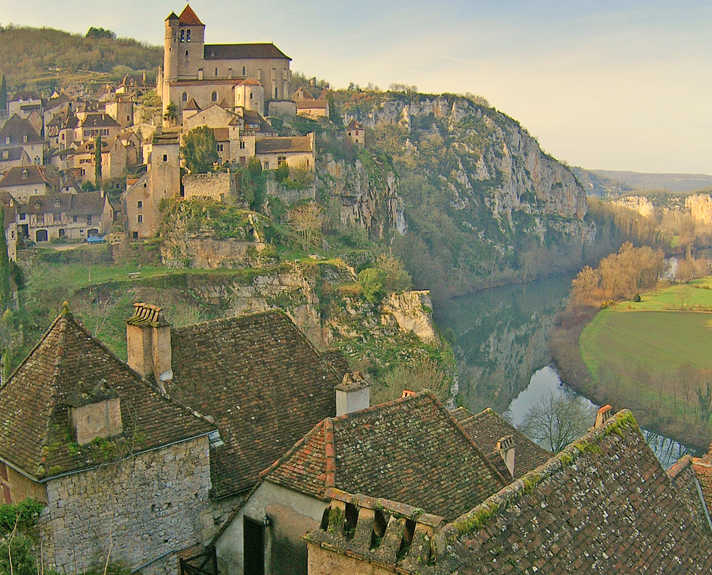Saint-Cirq-Lapopie is a picturesque medieval village located in the Lot department in the Occitanie region, in Quercy, in south-western France.
Saint-Cirq-Lapopie is located on the southwestern edge of the Massif Central on the cliffs of the left bank of the Lot, about one kilometer from the confluence of the Célé in the Lot.
The main city of one of the three Visconies in Chiersey, Saint-Cirq Lapopie, during the Middle Ages, belonged to several feudal dynasties, the main surnames of which were Lapopies, Gourdons and Cardaillacs. As a result, several castles and fortresses were built here, each stronger than the other, towering over the feudal village.
In the 20th century, Saint-Cirq Lapopie became a favorite destination for artists and writers. Post-impressionist painter Henri Martin (1860–1943), photographer Man Ray (1890–1976), and many others stayed in the village at the invitation of renowned gallery owner and talented art connoisseur Joseph Rignault.
Saint-Cirq Lapopie, a small medieval village with 200 inhabitants, offers tourists several convenient parking lots. You can park your car near the village, and then walk along its old streets on foot ,is one of the most famous sites in the Lot Valley. It is located on the cliffs of the left bank of the Lot, almost 100 meters above the river, in the center of the Causses du Quercy Regional Nature Park.
The place, which is towered over by the ruins of the former castle and enclosed by a city wall, is entered through fortified gates. The steep streets of the village are characterized by tile-roofed gabled houses from the 13th to 16th centuries. Many artists have settled in the village and offer their products. At the foot of the Lapopie rock, mills, locks and the harbor and the towpath are reminiscent of the time of the flourishing inland navigation on the Lot.
Access : Coordinates: 44.4653, 1.6706 / The town is located 30 km east of Cahors in the heart of the Causses du Quercy regional natural park.
Highlights :
- Saint-Cirq-Lapopie has been declared one of the most beautiful villages in France by the association Les plus beaux villages de France./ Medieval houses of the bourgeois
Facing the square, you will see numerous half-timbered houses, whose arcades date back to the 13th – 14th centuries. - Château de Cardaillac : Near the church are the ruins of a fortified structure, the main building of which was based on a Romanesque donjon with buttresses. / Château de St-Cirq Lapopie.
- The Romanesque church from the 12th century stands below the castle ruins./ The Sainte-Croix chapel. / Porte de la Perolerie , the remains of a gate protected by a descending lattice.
- The Célé variant (long-distance hiking trail GR 651) of the French Way of St. James, Via Podiensis, leads through Saint-Cirq-Lapopie. This variant is marked as the GR 651 long-distance hiking trail.
- The watermill at the foot of the Lapopie rock was mentioned in a document as early as 1317 / Belvedere of the circus of Vènes: A small iron cross indicates the access to the point of view on the plain of Tour-de-Faure and the cirque of cliffs of Vènes.
- Saffron cultivation : Crocus sativus has been cultivated in Quercy since the Middle Ages and its saffron is renowned. A document dating from 1468 attests to the presence of a saffron farm at Porte Roques, in the parish of Saint-Cirq-Lapopie.
- La Maison Daura, the house of the painter Pierre Daura, was made available by his daughter Martha to the regional council of the Midi-Pyrénées region in order to offer young artists the opportunity to exhibit their works.
- the medieval castle Château de la Gardette, which has now been turned into a museum
- Musée Rignault. : Trignault Museum, where temporary exhibitions of contemporary art take place. Émile-Joseph Rignault (1874-1962), passionate about art and collector, donated it in 1946 to the General Council of Lot.
- Belvédère du Bancourel: At the foot of a circular dovecote from the 16th century, the Bancourel esplanade offers a spectacular view of the Lapopie rock and the Aulanac lock
- La Popie rock : At the end of the cliff, la popie was the site where the first castle was erected in the 10th century, which was rebuilt in the 12th century.
- Ganil towpath: Preceded by the mill and the lock keeper, this towpath cut into the side of the cliff is one of the most spectacular routes in the valley. The walk begins at the Plage-Halte nautique de Saint-Cirq-Lapopie: Beach, about 10 km round trip.
- André Breton (1896–1966) was also attracted by the beauty of Saint-Cirq-Lapopie. His house, Auberge des Mariniers, is the oldest in the village. / Maison de la Fourdonne /
- Turning in Saint-Cirque-Lapopie. : Turning became one of the most important industries in the village even before the beginning of the 15th century, after the second stage of the Hundred Years War. With the development of winemaking in the region in the 19th century, this craft began to flourish.
- L’Auberge de Mariniers : It is the oldest house in Saint-Cirq-Lapopie, dating from the 13th century / Place du carol / La Chapelle de Mariniers- Chapel of the sailors. / Rue de la Pélissaria / Porte de la Pélissaria – Pelissaria Gate.
- St Cirq Lapopie is surrounded by many attractions and opportunities for outdoor activities: on foot, by bike, on horseback, kayak.etc.
Go next : The village of Limogne-en-Quercy is located 15 km from Saint-Cirq / Chemin de halage : Discover the amazing path along the sheer cliff that runs from the foot of Saint-Cirq-Lapopie to Bouziès. / The next town is Cahors / The nearest major French cities are Toulouse (97 km) in the south, Bordeaux (184 km) in the north-west and Montpellier (200 km) in the south-east.

